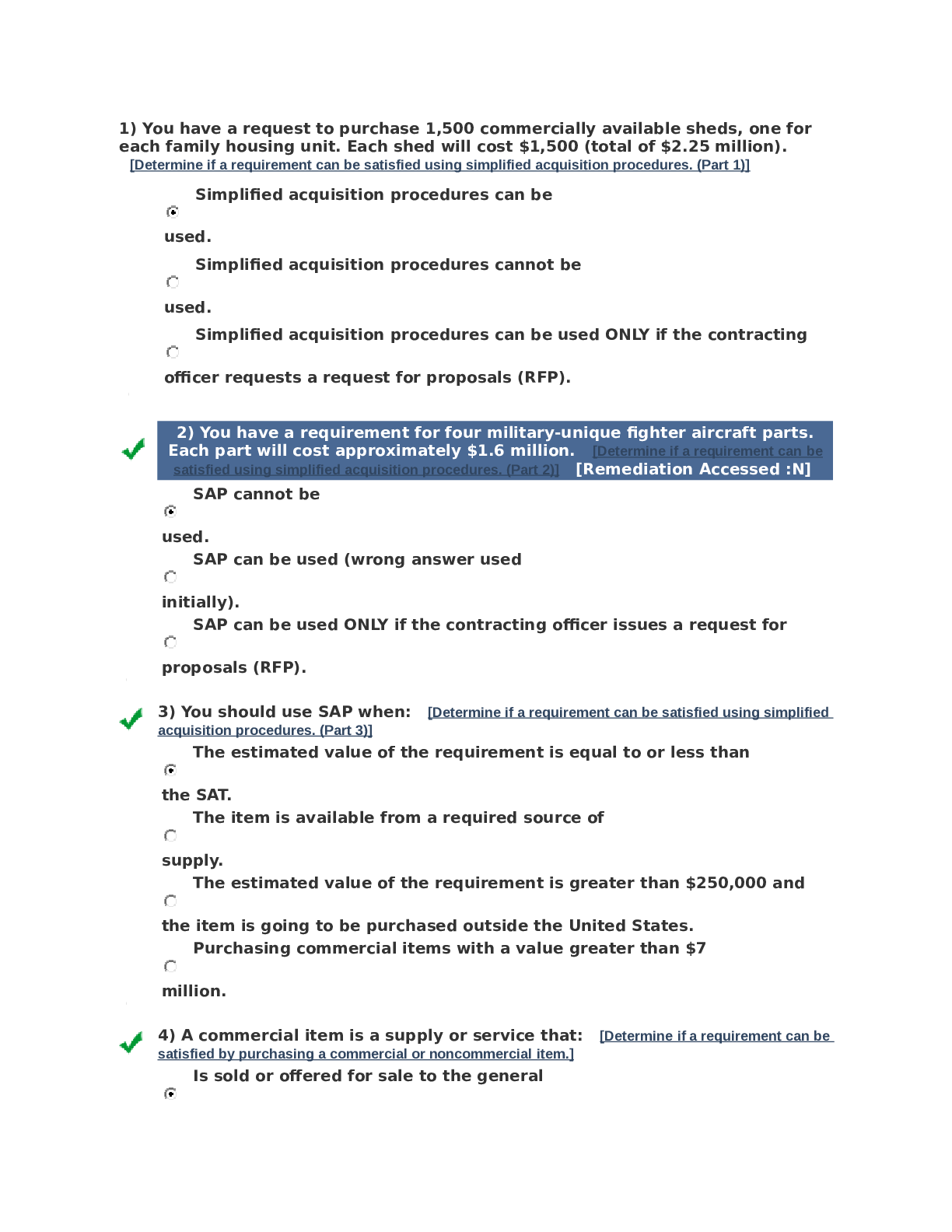*NURSING > QUESTIONS & ANSWERS > ACSM CPT Exam Review Questions with Correct Answers (All)
ACSM CPT Exam Review Questions with Correct Answers
Document Content and Description Below
ACSM CPT Exam Review Questions with Correct Answers What is the function of the tricuspid valve? A. It acts as a pacemaker. B. To pump blood through the heart. C. Prevents backflow of blood to th... e left atrium. D. Prevents backflow of blood to the right atrium. - Answer: D What is the fundamental unit of muscle contraction? A. Myofibril B. Sarcomere C. Myosin D. Sarcolemma - Answer: B Which chamber of the heart is responsible for pumping oxygenated blood to the body? A. Right ventricle B. Left ventricle C. Right atrium D. Left atrium - Answer: B What is the natural curve in the lumbar region of the spine? A. Kyphotic curve B. Scoliotic curve C. Lordotic curve D. Myotic curve - Answer: C Adenosine triphosphate production via "anaerobic" glycolysis is associated with the significant formation of what by-product? A. Pyruvic Acid B. Phosphoric Acid C. Citric Acid D. Lactic Acid - Answer: D The changes in muscle size associated with long-term resistance training is most likely due to increases in _____. A. muscle fiber cross-sectional diameter. B. muscle fiber number. C. connective tissue thickness. D. hydration state of the muscle. - Answer: ADownhill walking/jogging/running is characterized by eccentric activation of which of the following muscle groups? A. Hamstrings B. Gastrocnemius C. Brachioradialis D. Quadriceps femoris - Answer: D What is the typical resting blood pressure response to long term aerobic exercise in a hypertensive individual? A. Both systolic and diastolic pressures will increase. B. Both systolic and diastolic pressures will decrease. C. Systolic will increase, while diastolic will remain unchanged. D. Systolic will decrease, while diastolic will remain unchanged. - Answer: B How does heart rate increase in relation to work rate and oxygen uptake during dynamic exercise? How does heart rate increase in relation to work rate and oxygen uptake during dynamic exercise? A. Exponentially B. Linearly C. Curvilinearly D. Inversely - Answer: B Which cardiovascular training approach, if repeated frequently, is most likely going to lead to overtraining? A. One intensive day followed by three easy days. B. One long day followed by three shorter duration days. C. Two consecutive intensive days, followed by one easy day. - Answer: C What feature is unique to skeletal muscle as compared to cardiac muscle? A. Absence of striations B. Presence of branching C. Requires nervous system stimulation D. Presence of intercalated disks - Answer: C What is the correct path of blood flow through the chambers of the heart? A. Left ventricle; left atrium; right atrium; right ventricle. B. Right ventricle; right atrium; left atrium; left ventricle. C. Left atrium; right atrium; left ventricle; right ventricle. D. Right atrium; right ventricle; left atrium; left ventricle. - Answer: D What respiratory muscles can cause forceful expiration? A. External intercostals B. Pectoralis minorC. Sternocleidomastoid D. Internal intercostals - Answer: D Which of the following occurs when walking or running up an incline? A. Greater flexibility of the soleus B. Lesser force of action from the gluteus maximus C. Lesser force of action of the knee extensors D. Lesser flexibility of the plantar flexors - Answer: A What two muscles, along with the supraspinatus and infraspinatus, make up the rotator cuff? A. Teres minor and scalenus B. Teres minor and subscapularis C. Teres major and scalenus D. Teres major and subscapularis - Answer: B What muscle action will most likely induce delayed onset muscle soreness? A. Concentric B. Eccentric C. Isometric D. Isotonic - Answer: B What occurs to a muscle during the eccentric movement phase of an exercise? A. Shortens while contracting B. Shortens while relaxing C. Lengthens while relaxing D. Lengthens while contracting - Answer: D What is the primary muscle group involved in trunk flexion while standing during the eccentric phase of the movement? A. Iliopsoas B. Rectus Abdominis C. Erector Spinae D. Biceps Femoris - Answer: C What muscle extends the forearm? A. Supinator teres B. Pronator teres C. Biceps brachii D. Triceps brachii - Answer: D What is the term used to describe the body's ability to utilize oxygen during exercise? A. Lactate threshold B. Anaerobic threshold C. Anaerobic capacityD. Oxygen consumption - Answer: D Which of the following is also known as the Trunk Flexion Test? A. Sit-and-reach test. B. Curl-up test for muscular endurance. C. Sit-up test for muscular endurance. D. Any test that requires clients to touch their toes. - Answer: A What is the order of stretching techniques from lowest risk of injury to highest risk of injury? A. Ballistic; slow static; proprioceptive neuromuscular facilitation. B. Slow static; ballistic; proprioceptive neuromuscular facilitation. C. Proprioceptive neuromuscular facilitation; ballistic; slow static. D. Slow static; proprioceptive neuromuscular facilitation; ballistic. - Answer: D Which of the following joints has the greatest range of motion, and involves the greatest number of movements? A. Knee joint B. Shoulder joint C. Hip joint D. Ankle joint - Answer: B What change may occur between heart rate and blood pressure as a result of chronic exercise? A. Resting heart rate and resting blood pressure are reduced. B. Resting heart rate reduces, but resting blood pressure stays the same. C. Maximal heart rate increases but maximal blood pressure stays the same. D. Resting heart rate and resting blood pressure stay the same, but maximal heart rate and maximal blood pressure are reduced. - Answer: A Which of the following is a result of chronic aerobic training? A. Increased lipid production. B. Decreased plasma triglyceride levels. C. Decreased high-density lipoprotein (HDL) levels. D. Increased low-density lipoprotein (LDL) levels. - Answer: B Mitral valve prolapse is a condition which primarily affects the . A. Sino-atrial node. B. Bicuspid valve. C. Tricuspid valve. D. Descending aorta. - Answer: B What action is involved in the concentric phase of the biceps curl? A. Flexion at the elbow.B. Extension at the elbow. C. Pronation of the forearm. D. Supination of the forearm. - Answer: A Cardiac output is a product of heart rate multiplied by ___________. A. peripheral resistance. B. blood pressure. C. blood volume. D. stroke volume. - Answer: D Which of the following best describes the symptoms that occur at 24-48 hours after a single bout of intensive exercise? A. Delayed onset muscle strain. B. Acute onset muscle strain. C. Delayed onset muscle soreness. D. Acute onset muscle soreness. - Answer: C Which principle of training best describes a previously active client, who has been ill and bedridden for a prolonged period of time? A. Overload B. Specificity C. Reversibility D. Progression - Answer: C If you are palpating the thumb side of the forearm in the wrist area, what pulse are you checking? A. Humeral B. Ulnar C. Brachial D. Radial - Answer: D What is the correct order of the regions of the spinal column, from superior to inferior? A. Cervical, lumbar, thoracic, sacral and coccyx. B. Coccyx, sacral, lumbar, thoracic, and cervical. C. Cervical, thoracic, lumbar, coccyx, and sacral. D. Cervical, thoracic, lumbar,sacral, and coccyx. - Answer: D Which muscle is an antagonist of the hamstrings? A. Gastrocnemius B. Iliopsoas C. Gracilis D. Sartorius - Answer: BWhich of the following physiological changes does NOT occur when a client improves aerobic capacity? A. The muscles will be able to extract more oxygen from the blood. B. Total lung volume will increase in proportion to the total accumulated time of highintensity exercise. C. The oxygen carrying capacity of the blood will increase. D. The amount of air the lungs can take in will increase because of increases in the rate and depth of breathing. - Answer: B As the intensity of dynamic exercise increases, which of the following sets of responses occurs? A. Heart rate, systolic blood pressure, and diastolic blood pressure increase. B. Heart rate and systolic blood pressure increase, diastolic pressure remains unchanged. C. Heart rate and systolic blood pressure increase, stroke volume and cardiac output remain the same. D. Stroke volume decreases, heart rate and cardiac output increase. - Answer: B From a seated position, with dumbbells to the sides, raising the dumbbells laterally to shoulder level with elbows slightly flexed, exercises primarily the _______: A. bicep brachii and latisimus dorsi B. posterior deltoid C. anterior deltoid and triceps brachii D. middle deltoid. - Answer: D What is the major muscle used to flex the hip joint? A. Vastus lateralis B. Iliopsoas C. Biceps femoris D. Gluteus maximus - Answer: B A subject with elbows held at 90 degrees of flexion is handed a 150 lb (68.1kg) barbell. Even though he exerts maximal tension, the barbell causes the joint angle to increase to 170 degrees. Which one of the following describes the muscle action during the extension? A. Isotonic concentric B. Isotonic eccentric C. Isokinetic concentric D. Isokinetic eccentric - Answer: BType II muscle fibers: A. Have a high capacity to generate energy through the electron transport system. B. Have a high capacity to generate energy from fat. C. Are recruited at a higher percentage of maximum force than Type I fibers. D. Have high endurance capabilities. - Answer: C Which of the following is a normal blood pressure (BP) response to aerobic exercise? A. Both systolic and diastolic BP increase proportionately to increases in workload. B. Systolic BP increases and diastolic BP decreases. C. Systolic BP increases proportionately to increases in workload and diastolic BP remains unchanged or decreases slightly. D. Systolic and diastolic BP both decrease at the onset of exercise, then increase in proportion to the increase in intensity. - Answer: C Which rotator cuff muscle abducts the arm? A. Infraspinatus B. Supraspinatus C. Subscapularis D. Medial deltoid - Answer: B Which energy system has the highest capacity for ATP production? A. ATP-CP B. Rapid glycolysis C. Slow glycolysis D. Oxidative phosphorylation - Answer: D What plane divides the body into upper and lower sections? A. Sagittal B. Frontal C. Transverse D. Median - Answer: C When performing neck flexion in the sagittal plane, which of the following exercises best mimics that movement? A. Cartwheel B. Somersault C. Bicep curl D. Leg curl - Answer: B Under which of the following circumstances would you expect to see the highest rise in blood lactate? A. During maximal exercise lasting between 60 and 180 seconds in the untrained clientB. Prior to treadmill walking in the cardiac patient C. During maximal exercise lasting between 60 and 180 seconds in the athlete D. After moderate intensity cycling exercise in the client with Type 2 diabetes - Answer: C Typical movements in the weight room such as a biceps curl using free weights and leg press actions using a machine are best described as ____________ muscle actions. A. plyometric B. isokinetic C. ballistic D. isotonic - Answer: D The latissimus dorsi acts as the prime mover during the concentric phase of which of the following exercises? A. lat pulldown B. flat bench press C. lateral raise D. incline bench press - Answer: A Which of the following bones facilitate movement of the chest during both inspiration and expiration? A. clavicle B. scapula C. carpal D. scalene - Answer: A Which of the following is characterized as a plane (uniaxial) joint? A. Coxal (hip) B. Atlantooccipital C. Radiocarpal (wrist) D. Sacroiliac - Answer: D Which of the following indicates the reason why a female who is pregnant should avoid exercise in the supine position after the first trimester? A. obstruction of arterial blood flow B. risk of orthostatic hypotension due to obstructed venous return C. obstruction of the diaphragm D. risk of decreased oxygen consumption due to pressure on the uterus - Answer: B As a response to a progressive resistance training program, which of the following demonstrates the predominant contribution to an increase in cross-sectional area of a muscle?A. atrophy and possibly hypertrophy B. hyperplasia and possibly hypertrophy C. atrophy and possibly hyperplasia D. hypertrophy and possibly hyperplasia - Answer: D What is an appropriate precaution and/or modification for exercising in higher ambient temperatures? A. Take salt tablets. B. Drink eight ounces of water once per hour. C. Select proper loose fitting, lightweight clothing. D. Train in clothes designed to trap and hold body heat. - Answer: C What is the intensity recommendation for the initial conditioning stage of a cardiovascular program? A. 10% to 20% of heart rate reserve B. 20% to 30% of heart rate reserve C. 40% to 60% of heart rate reserve D. 60% to 85% of heart rate reserve - Answer: C Approximately how long is the initial conditioning phase of a cardiovascular training program? A. Four weeks B. Eight weeks C. Twelve weeks D. Sixteen weeks - Answer: A What is the American College of Sports Medicine's recommendation regarding frequency to increase cardiorespiratory fitness? A. One to two days per week B. Two to three days per week C. Three to five days per week D. Four to six days per week - Answer: C What is the variability for any given age, when estimating a client's age-predicted maximum heart rate? A. 2 to 4 beats per minute B. 10 to 12 beats per minute C. 18 to 20 beats per minute D. 22 to 24 beats per minute - Answer: B What is the formula to determine 60% of heart rate reserve? A. 220 - age x 60% B. Maximum heart rate x 60%C. Maximum heart rate - resting heart rate x 60% D. Maximum heart rate - resting heart rate x 60% + resting heart rate - Answer: D A 50 year old client has a resting heart rate of 70 beats per minute. Calculate the exercise heart rate for this client using 50% of heart rate reserve. A. 85 beats per minute B. 100 beats per minute C. 110 beats per minute D. 120 beats per minute - Answer: D When should a client exhale during performance of a bench press? A. Only after the movement ends. B. Immediately before the movement begins. C. During the eccentric phase of the movement. D. During the concentric phase of the movement. - Answer: D What health-related physical fitness component is primarily emphasized in a circuit training program that has 30 stations, 60 seconds per station, at 25% of one repetition maximum? A. Muscular Strength B. Muscular Flexibility C. Muscular Endurance D. Muscular Power - Answer: C What is a result of resistance training in adolescents? A. It promotes muscular strength. B. It increases muscular bulk. C. It increases the risk of osteoporosis. D. It causes permanent musculoskeletal damage. - Answer: A A 35 year-old male client has a goal of completing a sprint distance triathlon. The certified Personal Trainer prescribes an exercise regimen of swimming 2 days per week, running 3 days per week, and bicycling 2 days per week. What training principle is being used? A. Reversibility B. Overload C. Progression D. Specificity - Answer: D What are the FITTE Factors? A. Frequency, injury, time, type, enjoyment B. Frequency, intensity, total, type, exercise C. Frequency, intensity, total, type, equipmentD. Frequency, intensity, time, type, enjoyment - Answer: D Why is a cool-down period important? A. Prevents heat stroke B. Helps prevent injuries C. Reduces brain blood flow back to normal D. Returns pooled blood back to central circulation - Answer: D Which of the following is NOT a principle of training? A. Overload B. Specificity C. Reversibility D. Concentration - Answer: D What is the first phase of an annual training cycle? A. Transition B. Off-season C. Preparatory D. Competition - Answer: C What is a function of the hamstring muscles? A. Hip flexors B. Hip extensors C. Plantar flexors D. Knee extensors - Answer: B What method of training combines a routine of alternating cardiovascular exercises with resistance training exercises? A. Circuit training B. Interval training C. Split routine training D. Periodization training - Answer: A What resistance training method is described by a light to heavy or heavy to light progression of sets? A. Pyramid B. Superset C. Negative set D. Volume training - Answer: A What resistance training method is being used when the client is performing a set of bicep curls immediately followed by triceps pushdowns? A. PyramidB. Supersets C. Plyometrics D. Split routine - Answer: B Together, the Centers for Disease Control and Prevention and the American College of Sports Medicine recommend that every US adult should accumulate _____ minutes or more of moderateintensity physical activity on most, preferably all days of the week. A. 15 B. 20 C. 30 D. 60 - Answer: C What is the predominant factor causing increases in strength during the initial weeks of training? A. Changes in whole muscle cross-sectional area B. Increases in overall limb circumference C. Improvements in neuromuscular adaptation D. Increases in muscle-fiber cross-sectional area - Answer: C Which of the following exercise program variables describes a change in intensity? A. Changing activity from treadmill to stair-stepper. B. Increasing a treadmill incline by five degrees. C. Increasing the number of workout days from two to three per week. D. Increasing treadmill running time from 20 to 30 minutes. - Answer: B What happens to the muscle during isometric tension development? A. Shortening of the muscle B. Lengthening of the muscle C. No change in the length of the muscle D. Relaxation of the muscle - Answer: C Which of the following is the most important exercise to include in an overall training plan for an apparently healthy automobile mechanic who performs daily overhead movements? A. Lat pulldown B. Upright Row C. Tricep extension D. Shoulder press - Answer: D A client's workout record shows changes in exercise volume and intensity over time. What training concept is being demonstrated? A. Specificity B. OvertrainingC. Reversibility D. Periodization - Answer: D When performing a seated leg extension, which muscle group is the primary antagonist during the concentric phase? A. Hamstrings B. Quadriceps C. Hip extensors D. Back extensors - Answer: A What position should women in their second or third trimester of pregnancy avoid when performing exercise? A. Prone B. Supine C. On their side D. On all fours (hands and knees) - Answer: B What is the suggested order of an exercise session? A. Stretch, warm-up, endurance phase, cool-down B. Warm-up, endurance phase, cool-down, stretch C. Stretch, endurance phase, warm-up, cool-down D. Warm-up, endurance phase, stretch, cool-down - Answer: B What does it mean if a specific activity is contraindicated? A. Perform less-intensively than normal B. Do not perform it as often C. Perform it slower than normal D. Do not perform at all - Answer: D Which of the following statements is true regarding exercise for the prepubescent child? A. Children are less tolerant of heat because of a higher threshold for sweating. B. Since children are anatomically immature, they should not participate in any form of resistance training exercise. C. Because of the lack of development of the epiphyseal growth plates, children should not participate in any form of endurance training. D. Both B and C are true - Answer: A Using the Heart Rate Reserve method, what is the target heart rate for a 40 year-old man with a resting heart rate of 70 beats/min, exercising at an intensity of 65%? A. 110 beats/min B. 129 beats/minC. 142 beats/min D. 180 beats/min - Answer: C A 45 year old male weighs 202 lb (92 kg). Skinfold analysis indicates 24% of his weight is fat. If he wants to decrease his body fat to 17%, what is his target body weight, assuming he maintains the same lean body mass? A. 168 lb (76 kg) B. 178 lb (81 kg) C. 185 lb (84 kg) D. 195 lb (89 kg) - Answer: C Which of the following exercises works best in isolating the soleus muscle? A. Standing heel raises B. Seated ankle extensions with the knees straight C. Seated heel raises with bent (flexed) knees D. Half squats with external rotation of the hip joint - Answer: C When doing a push-up on the floor, the motion at the elbow joint during the down phase is called ________ and the type of muscle action is called ________. A. extension, eccentric B. flexion, eccentric C. flexion, concentric D. extension, concentric - Answer: B Which of the following muscle groups must be strengthened in order to maintain a healthy back? A. Abdominals, knee flexors, and hip flexors B. Abdominals, hip extensors and erector spinae C. Abdominals, hip flexors and hip extensors - Answer: B Which of the following correctly describes the technique used in PNF (Proprioceptive Neuromuscular Facilitation)? A. Passively moving the muscle in dynamic motion to increase flexibility. B. A contract-relax sequence to relax the muscle stretch reflex mechanism. C. Using muscle contraction of the extensors followed by muscle contraction of the flexors. D. The required period of exercise for eliciting adaptation. - Answer: B An appropriate exercise to develop muscle endurance for the ________ is ________ . A. quadriceps; one set of 15 knee flexions at low resistance. B. triceps; one set of 15 repetitions of arm curls at low resistance. C. wrist flexors; one set of 15 repetitions of wrist curls at low resistance. D. hip abductors; one set of 15 repetitions of half-squats at low resistance. - Answer: CThe ACSM recommended exercise prescription for developing and maintaining muscular strength and endurance for health and fitness includes a minimum of: A. 1 set of 8-12 repetitions using 8-10 exercises that train the major muscle groups of the upper and lower body. B. 2-3 sets of 10-15 repetitions using 80% of the 1 repetition maximum (RM) for exercises that train the major muscle groups of the upper and lower body. C. 2-3 sets of 8-12 repetitions alternating days between upper and lower body exercises. D. 1-2 sets of 8-15 repetitions using 50-85% of the 1 repetition maximum (RM) for exercises that train the major muscle groups of the upper and lower body. - Answer: A As the percentage of 1 RM (Repetition Maximum) resistance increases: A. the amount of rest you should allow between training days should increase. B. the number of sets performed should increase. C. the number of repetitions until fatigue decreases. D. the amount of rest you should allow between sets should decrease. - Answer: C Which of the following describes a Valsalva maneuver performed during a free weight biceps curl? A. a normal part of the concentric phase of the exercise. B. inspiration of air through an open glottis. C. a normal part of the eccentric phase of the exercise. D. expiration of air against a closed glottis. - Answer: D You are working as a certified Personal Trainer, and have a client who recently confided to you that she is getting divorced. She admits to you that her exercise routine has suffered as a result of the increased stress. Which of the following actions is most appropriate for you to take? A. Recommend that she increase the duration of her sessions scheduled with you as a way to cope with this stressful situation. B. Recommend that she seek a mental health professional who can help her manage the increased stress. C. Make a future appointment with her to discuss the divorce. D. Recommend that she increase the number of sessions scheduled with you as a way to cope with this stressful situation - Answer: BA client exercising at a level 15 on the Borg Rating of Perceived Exertion Scale is likely to describe the exercise as ____________ . A. Very hard B. Hard C. Fairly light D. Very light - Answer: B Which of the following is the correct energy expenditure in METs associated with an exercise oxygen uptake of 28 ml''kg-1''min-1? A. 8 B. 10 C. 98 D. 112 - Answer: A What of the following is the formula for calculating the heart rate reserve? A. 220, minus the age of the client B. 220, minus the resting heart rate C. Client's maximum heart rate, minus their resting heart rate D. Client's maximum heart rate, minus their age - Answer: C What is the minimum duration of an intermittent bout of aerobic activity that may be accumulated throughout the day? A. 10 minutes B. 15 minutes C. 20 minutes D. 30 minutes - Answer: A Case study: A new client who has been resistance training for 6 months, comes to you with a goal of increasing muscular size. Following health appraisal and fitness testing including a modified 1 RM test, you design a program to meet the client's goal. Which of the following regimens best defines an appropriate plan to achieve this client's goal? A. 4-6 sets of 6-12 repetitions at 85% 1 RM B. 1-3 sets of 10-15 repetitions at 75% 1 RM C. 4-6 sets of 10-15 repetitions at 60% 1 RM D. 1-3 sets of 6-12 repetitions at 60% 1 RM - Answer: A A client who wants to strengthen muscles of the chest must perform exercises such as the bench press and dumbbell flys as opposed to lat pull down and dumbbell rows. Which of the followingprinciples of training best describes this principle? A. Overload B. Specificity C. Progression D. Goal setting - Answer: B The Valsalva maneuver may elicit which of the following physiological responses during the concentric phase of a resistance training repetition? A. Increased intrathoracic pressure and decreased heart rate B. Decreased systolic blood pressure and increased heart rate C. Increased intrathoracic pressure and increased systolic blood pressure D. Decreased heart rate and increased systolic blood pressure - Answer: C Which of the following is the term used for a training regimen that begins with rapid eccentric [Show More]
Last updated: 1 year ago
Preview 1 out of 37 pages
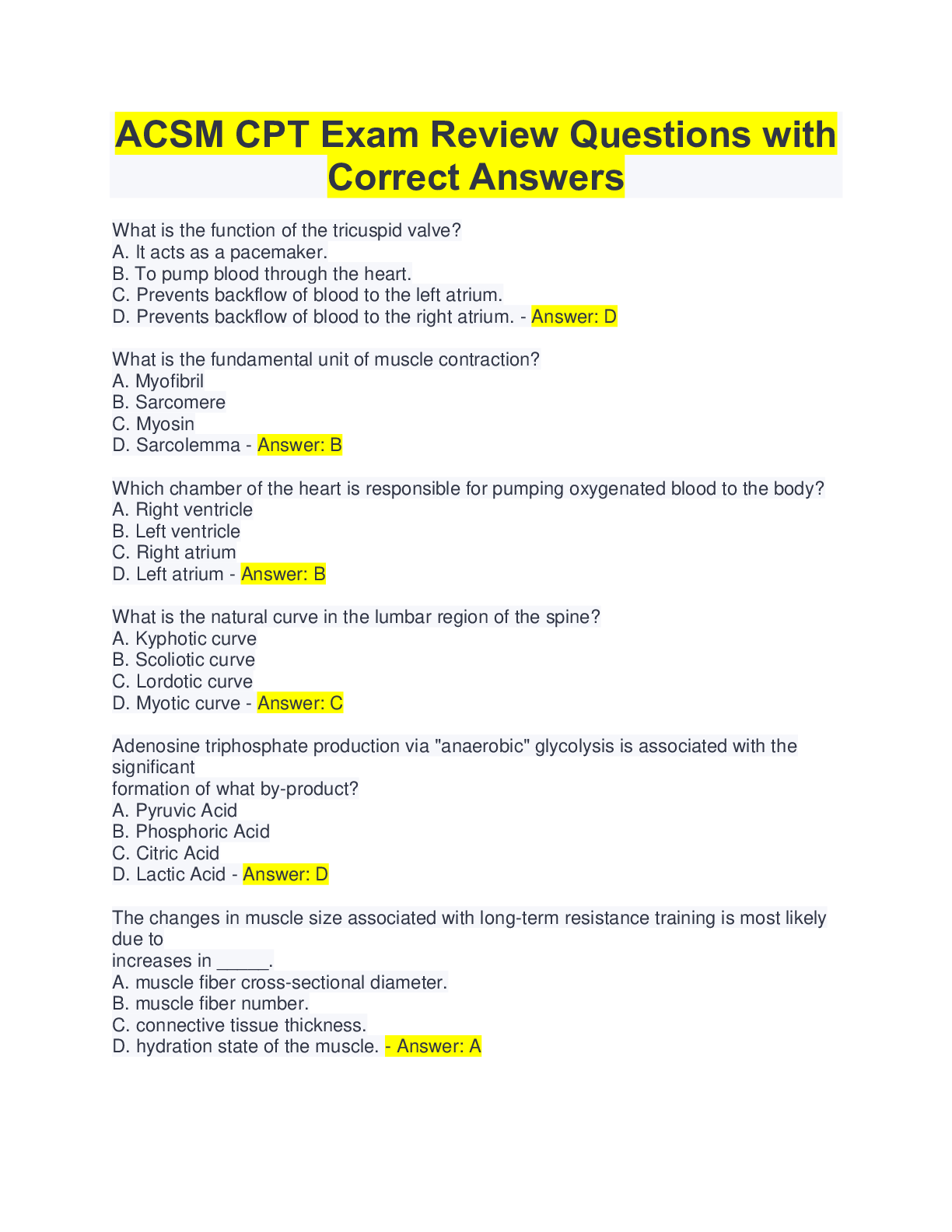
Reviews( 0 )
Document information
Connected school, study & course
About the document
Uploaded On
Jan 09, 2023
Number of pages
37
Written in
Additional information
This document has been written for:
Uploaded
Jan 09, 2023
Downloads
0
Views
214



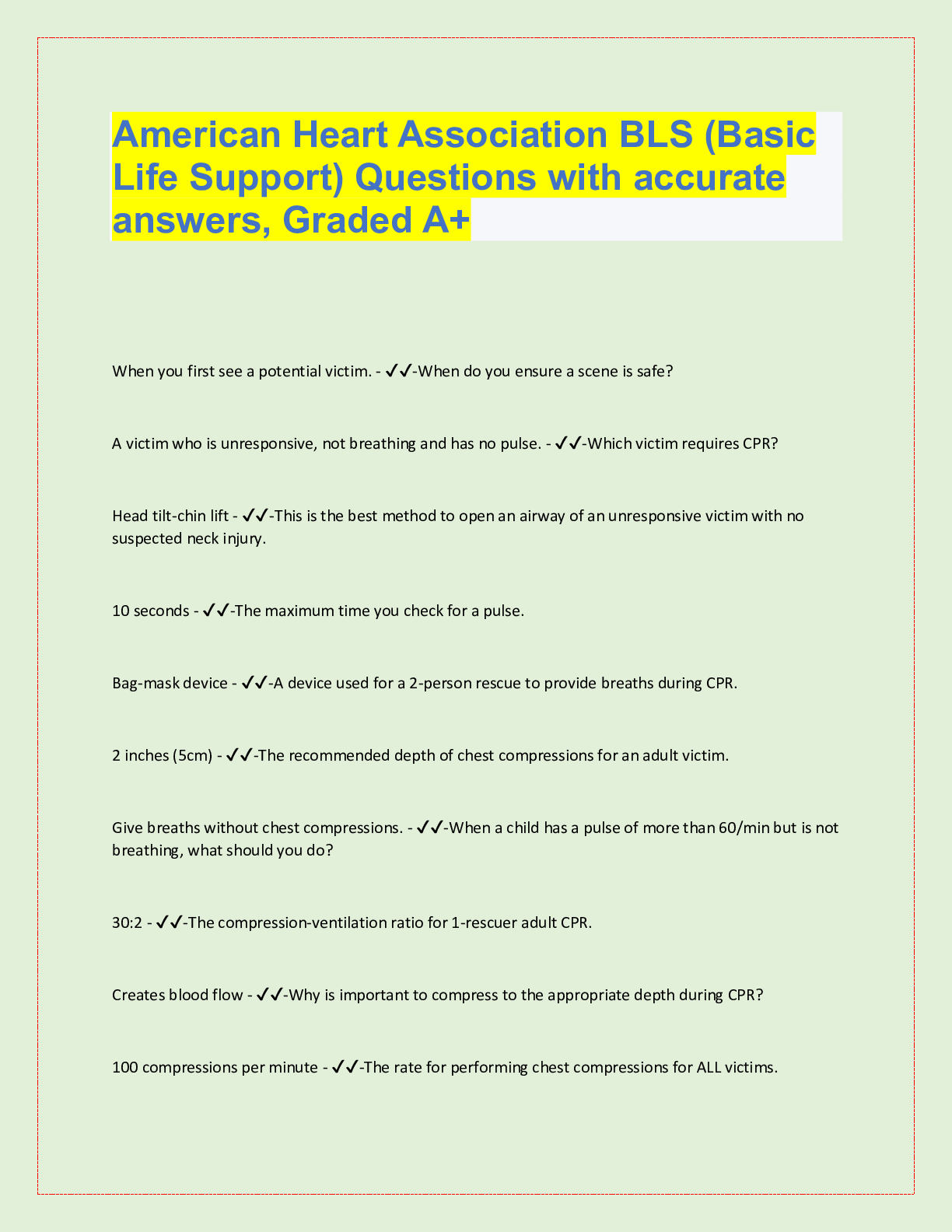


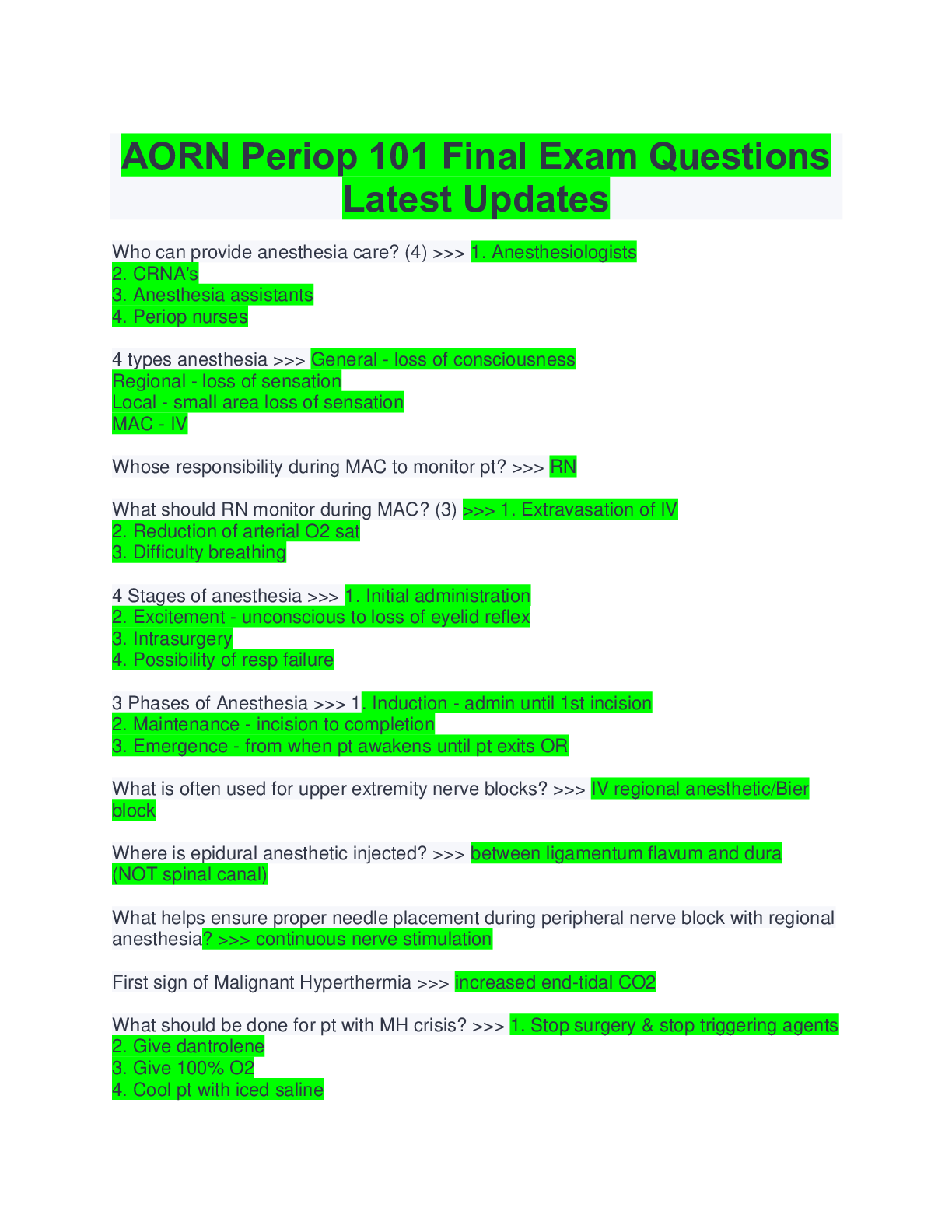






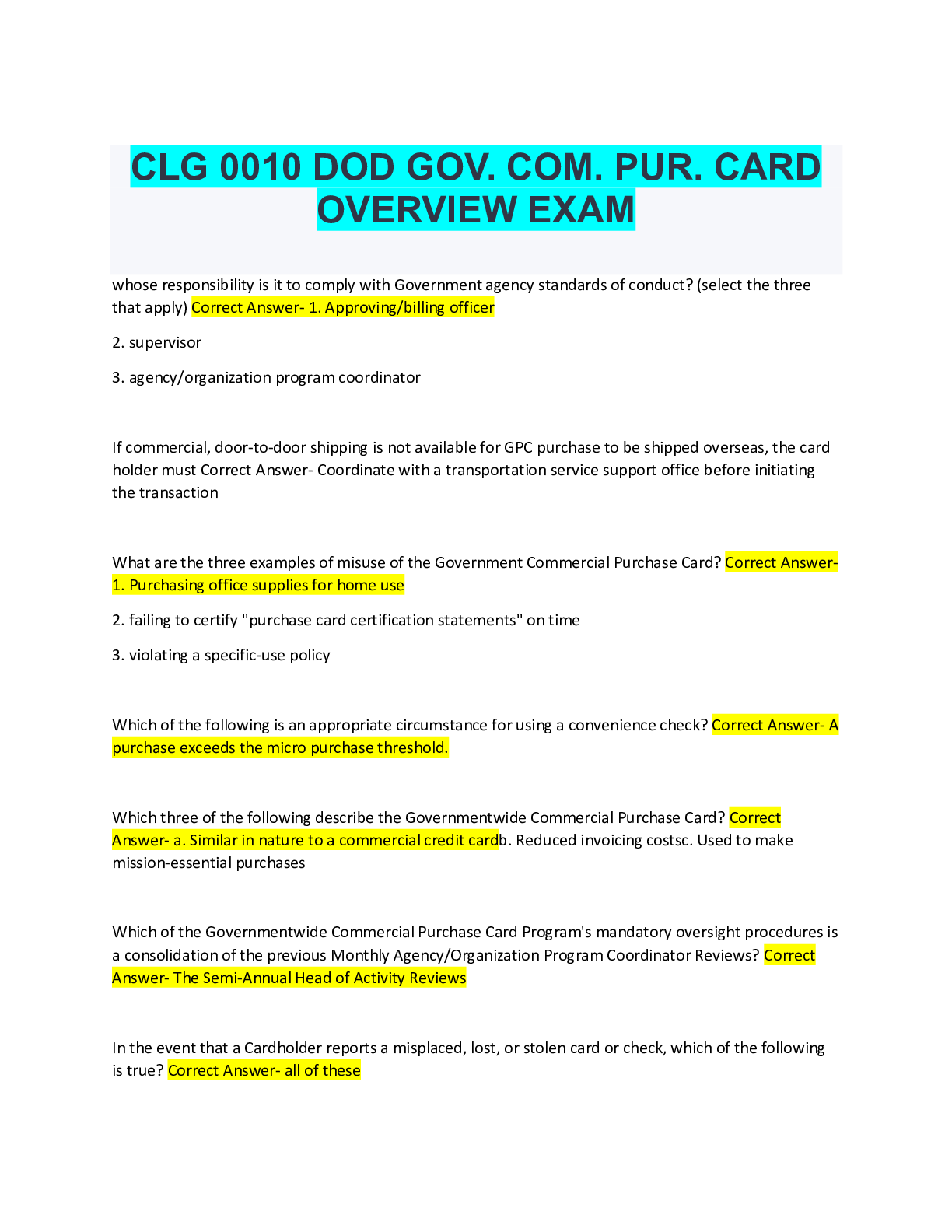


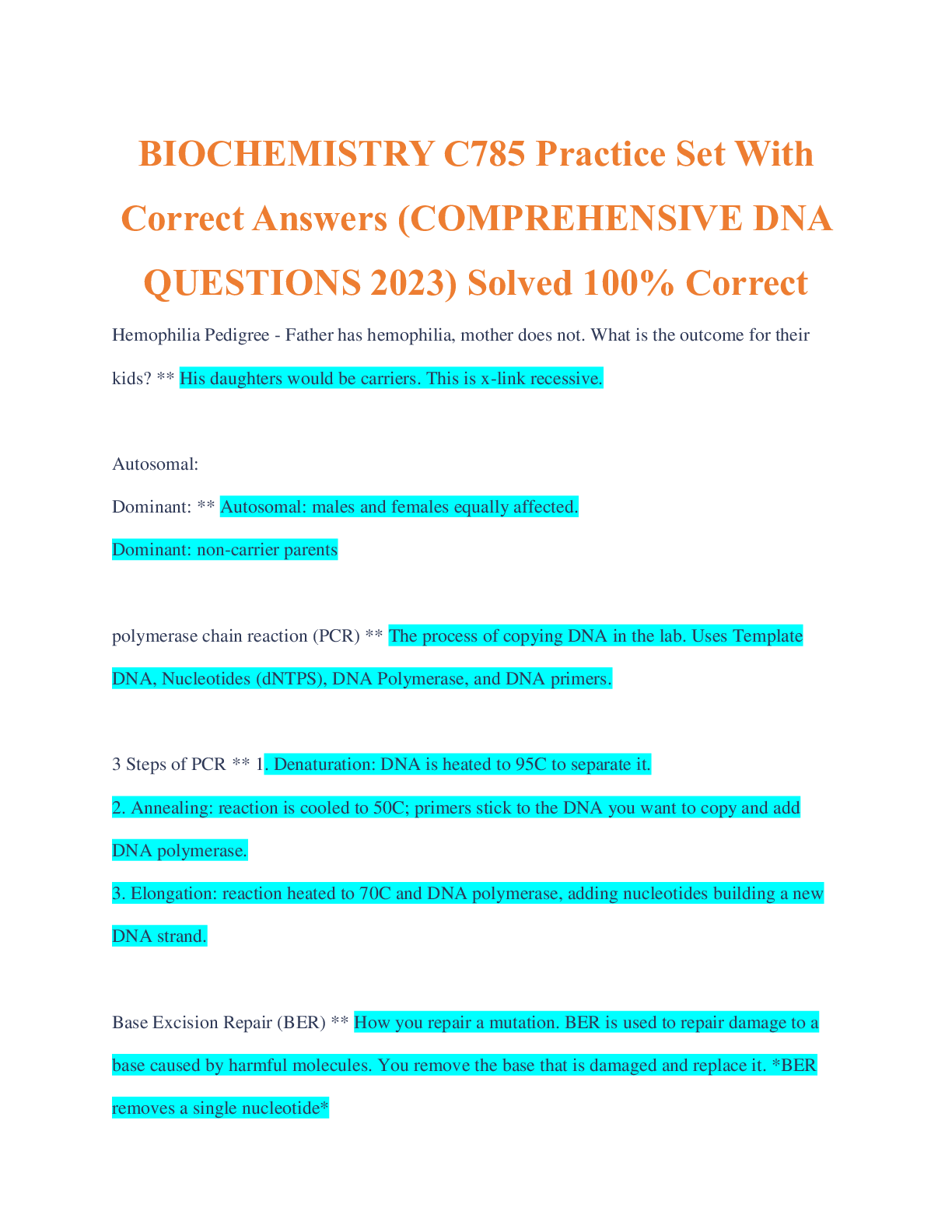
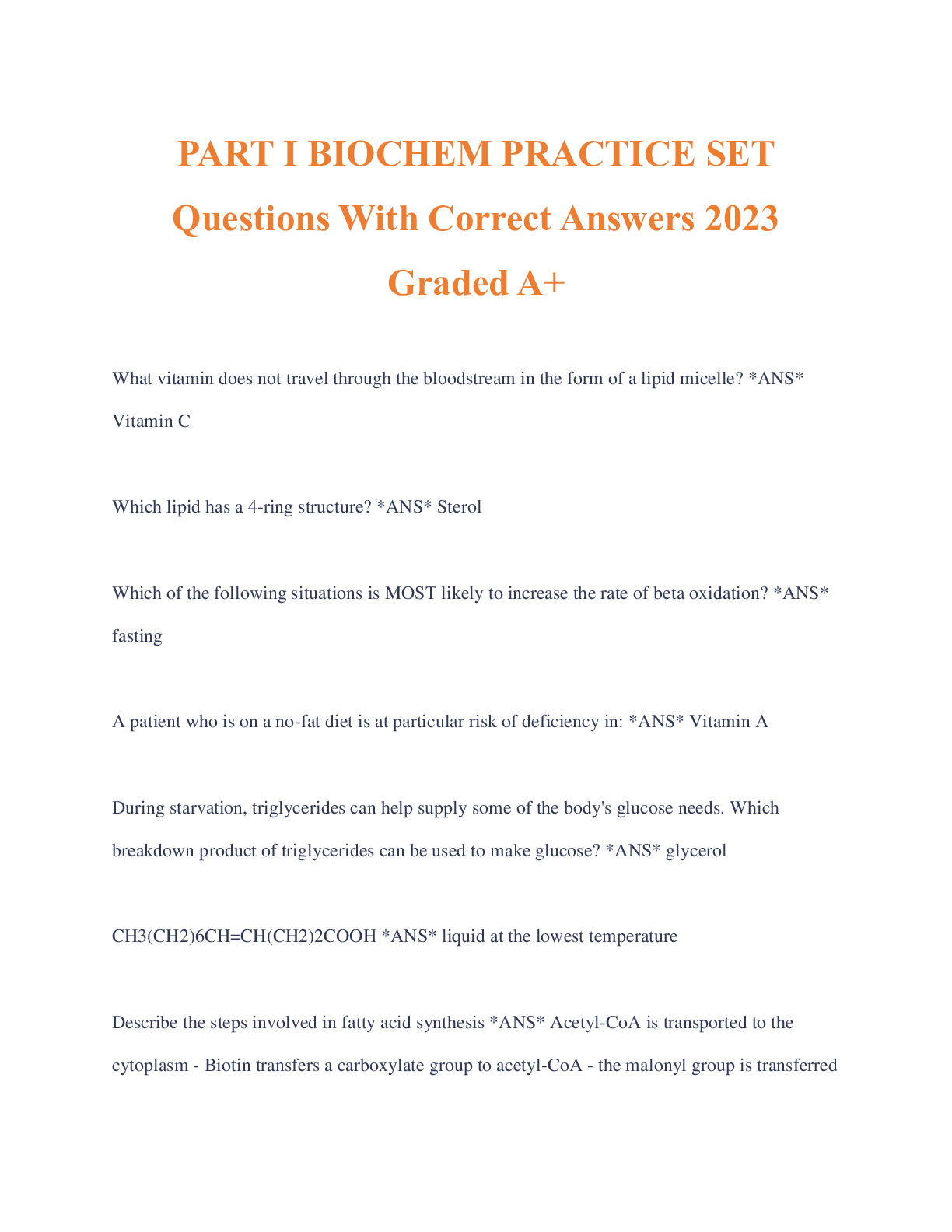
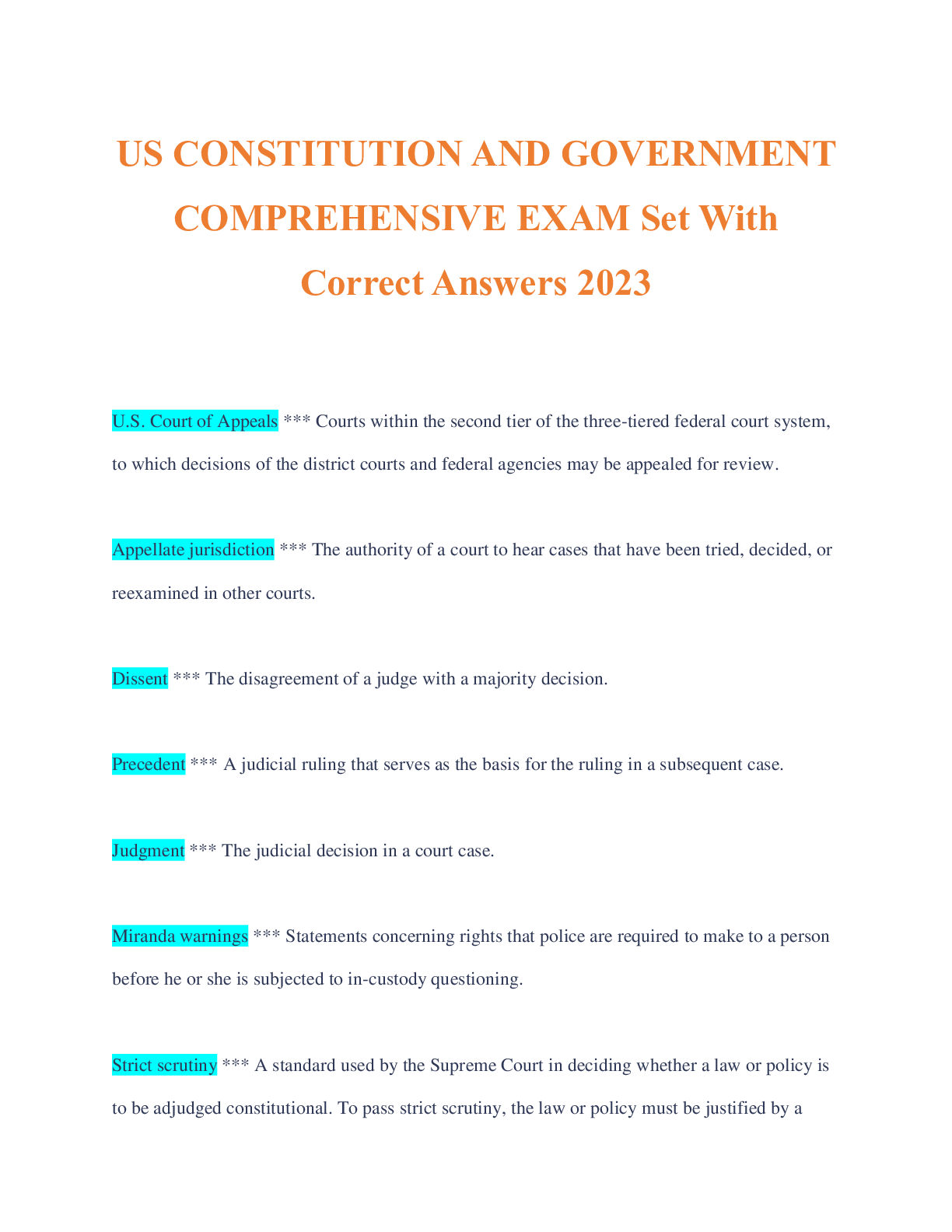
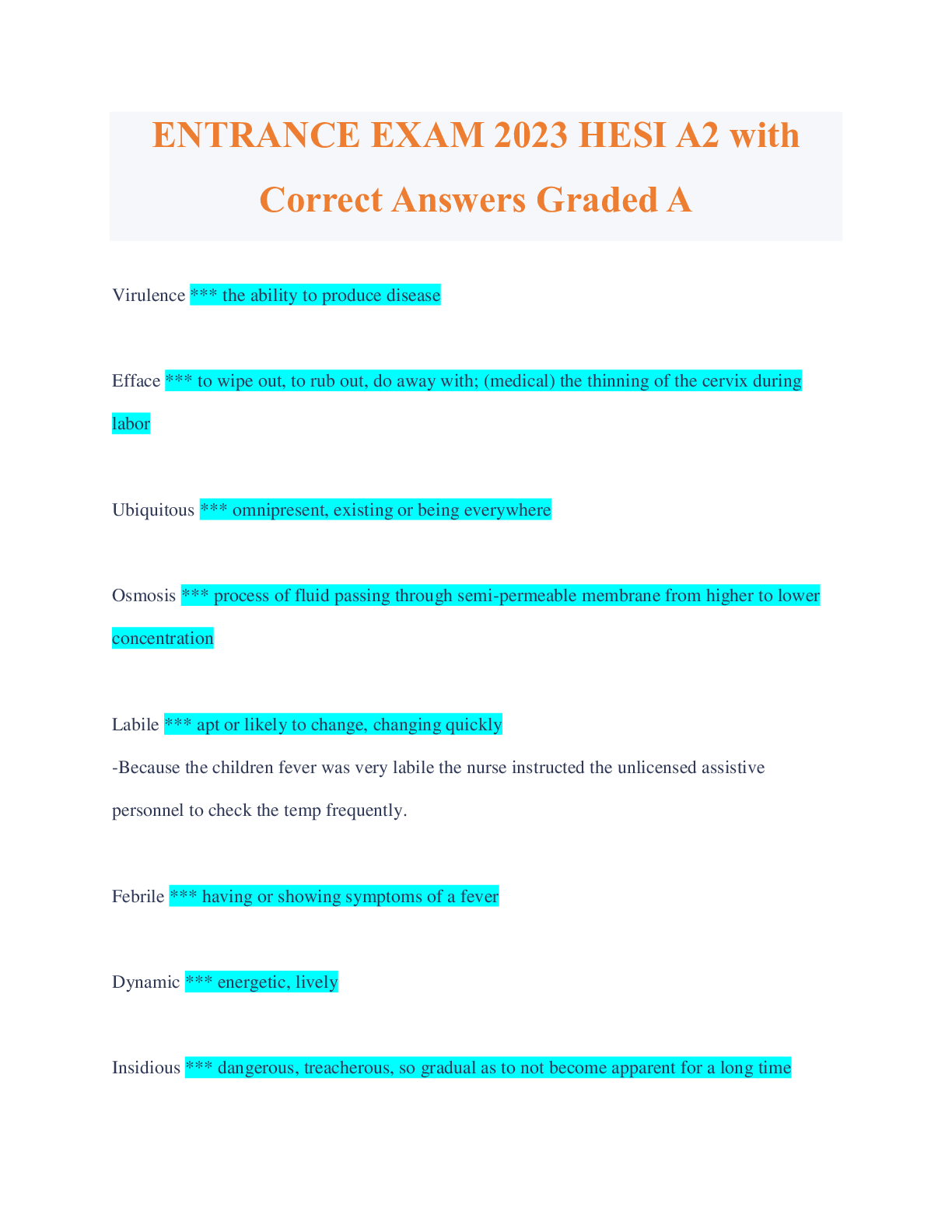
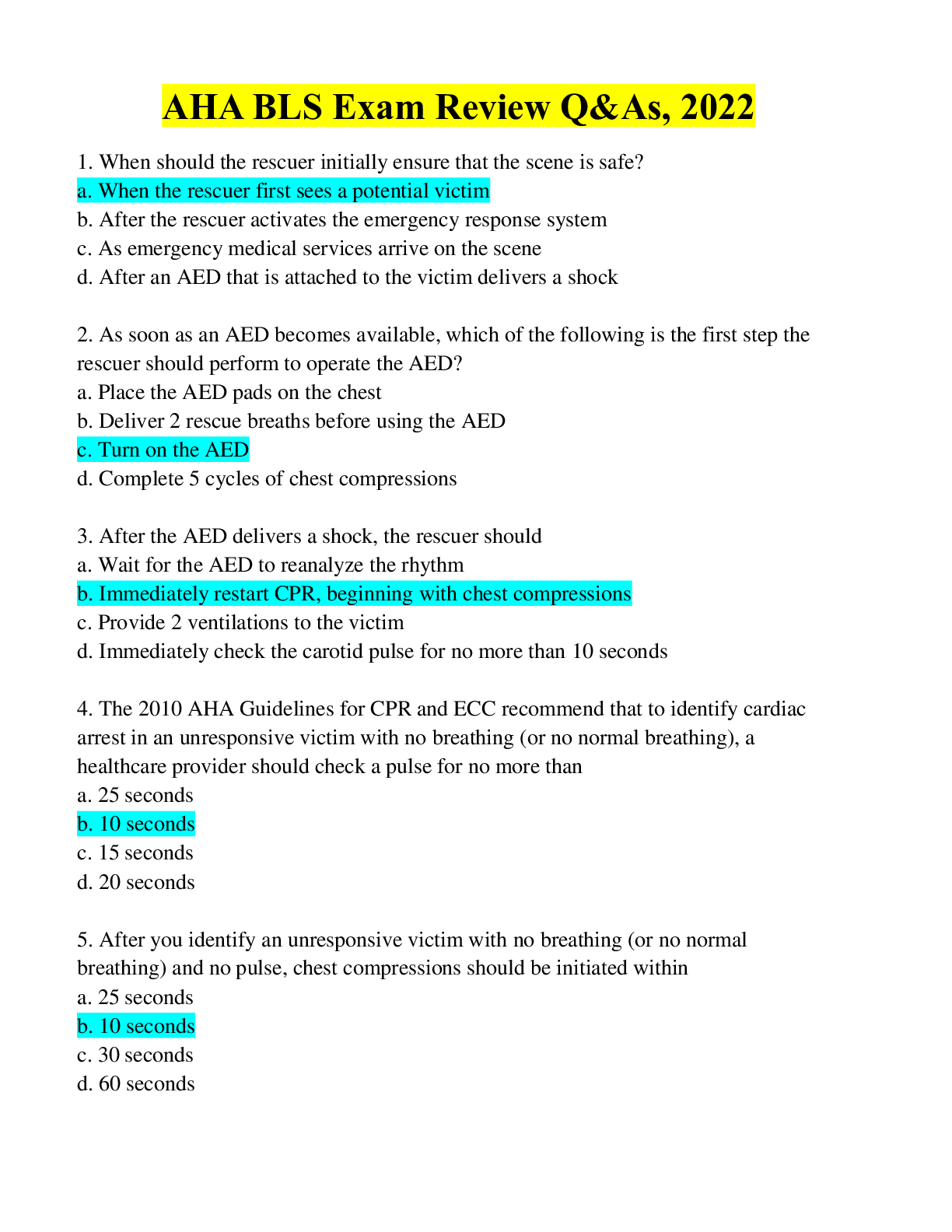


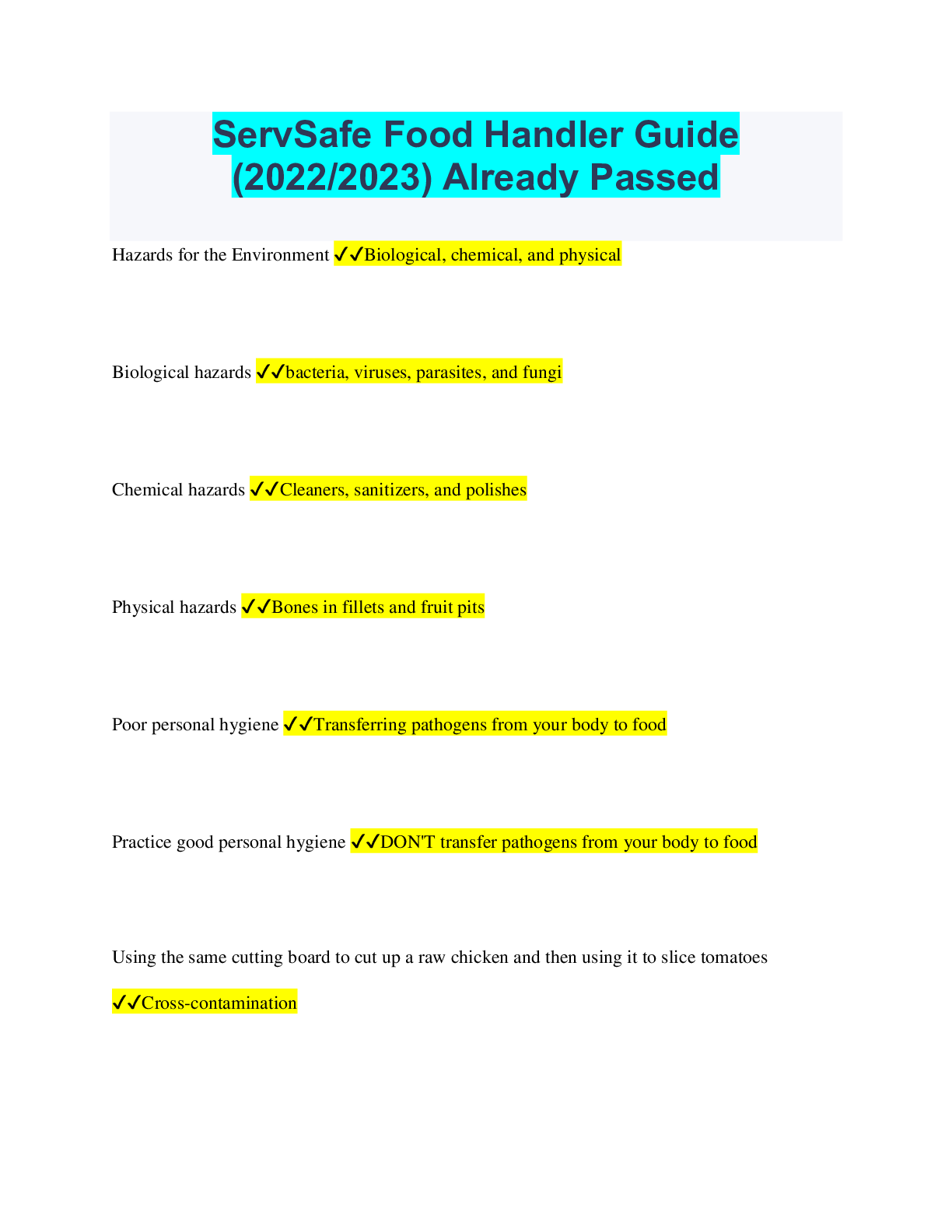
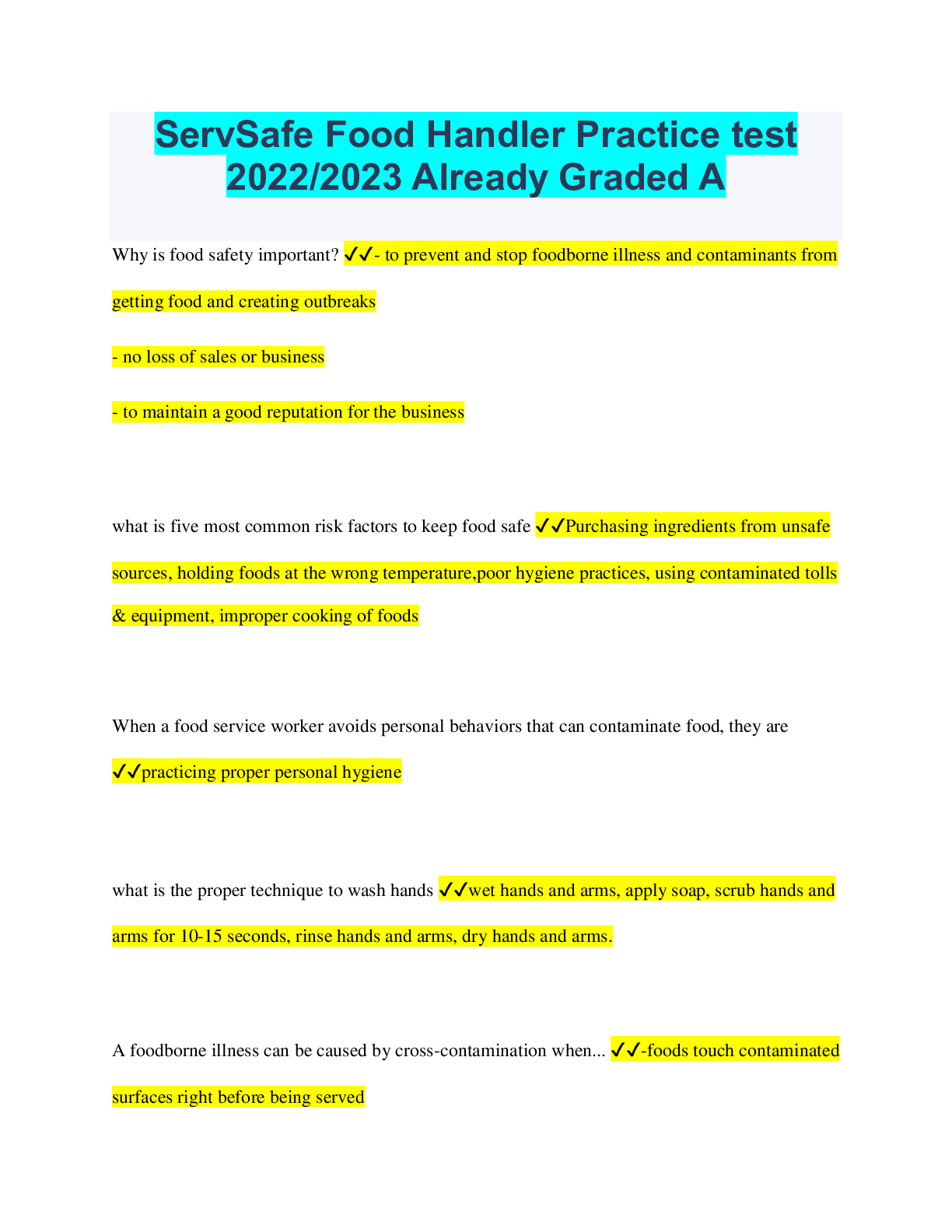
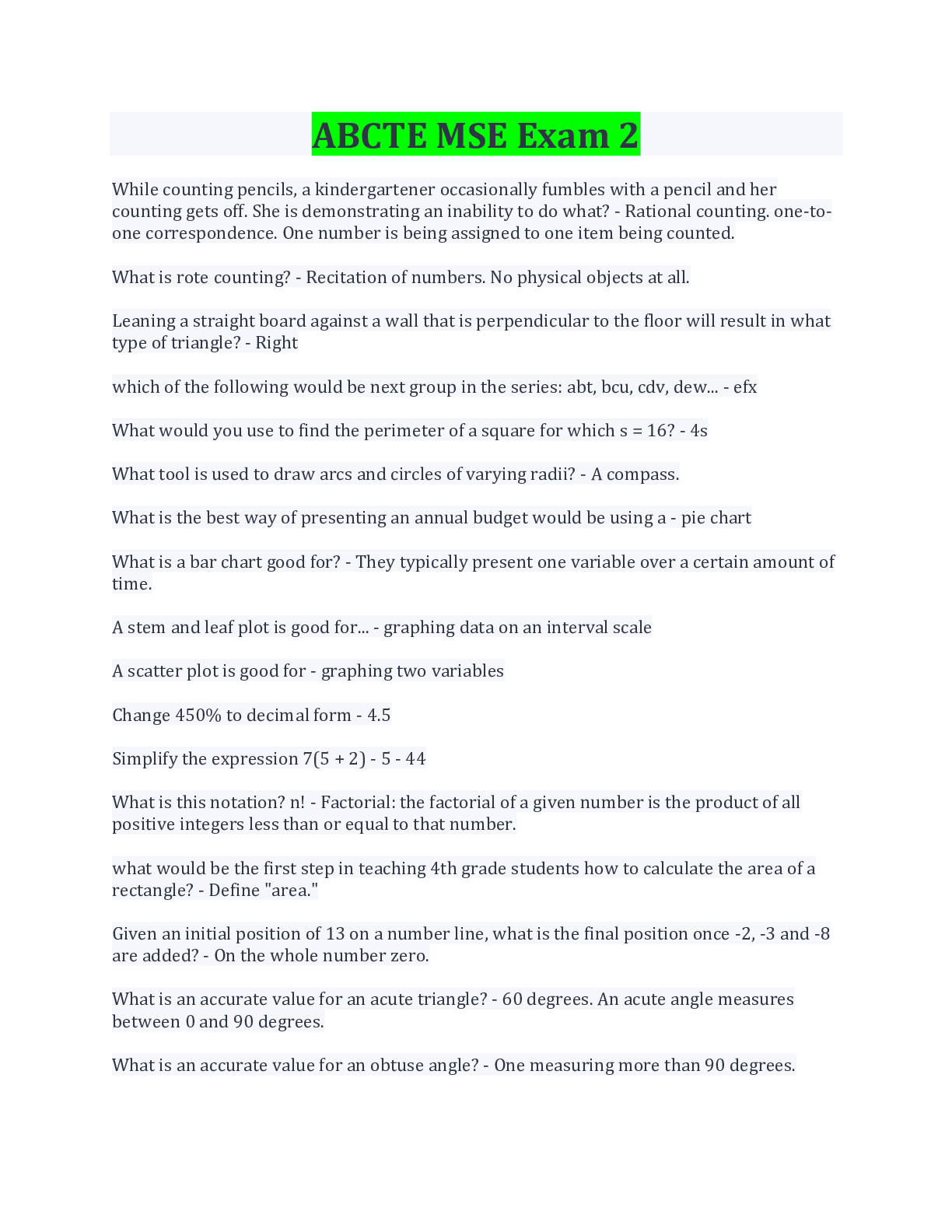


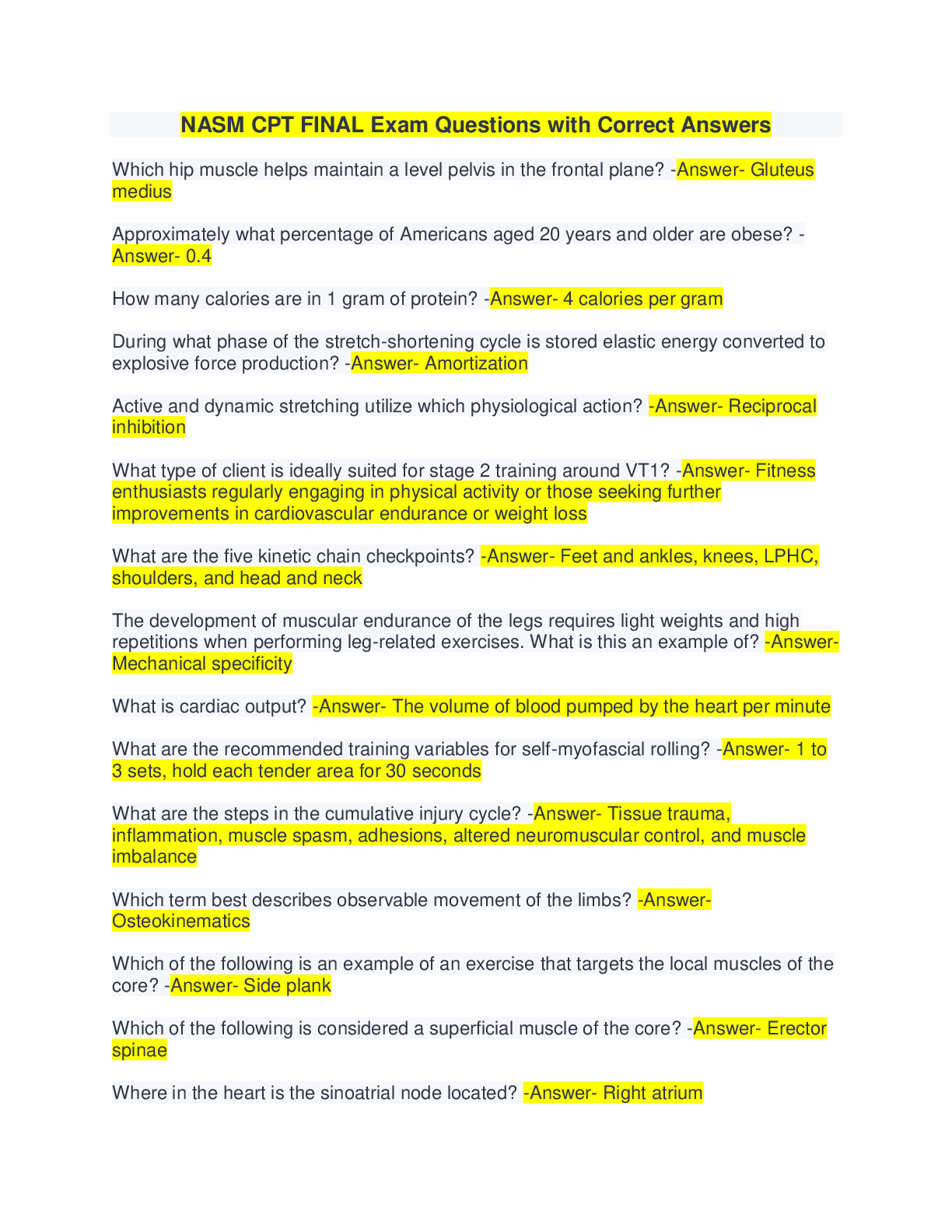

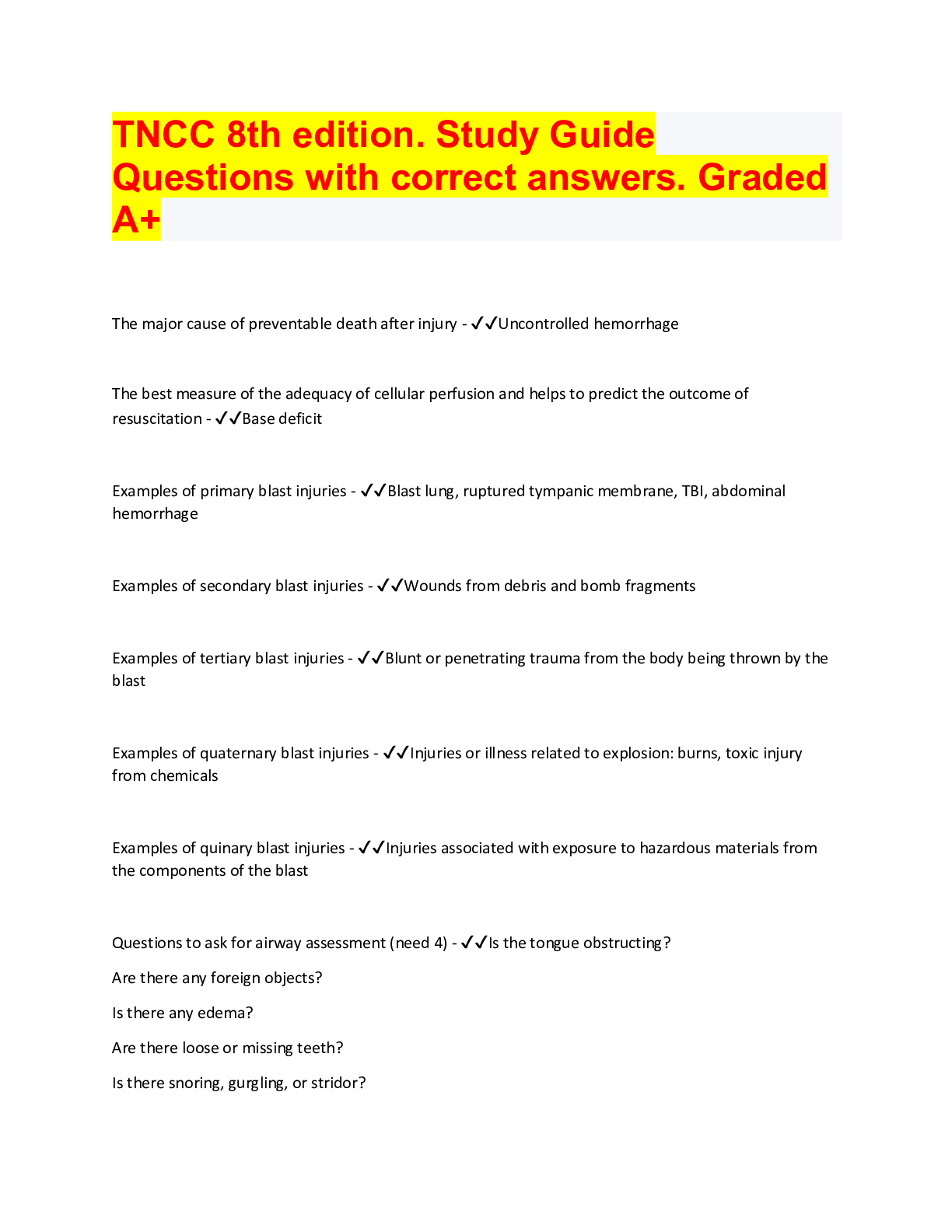

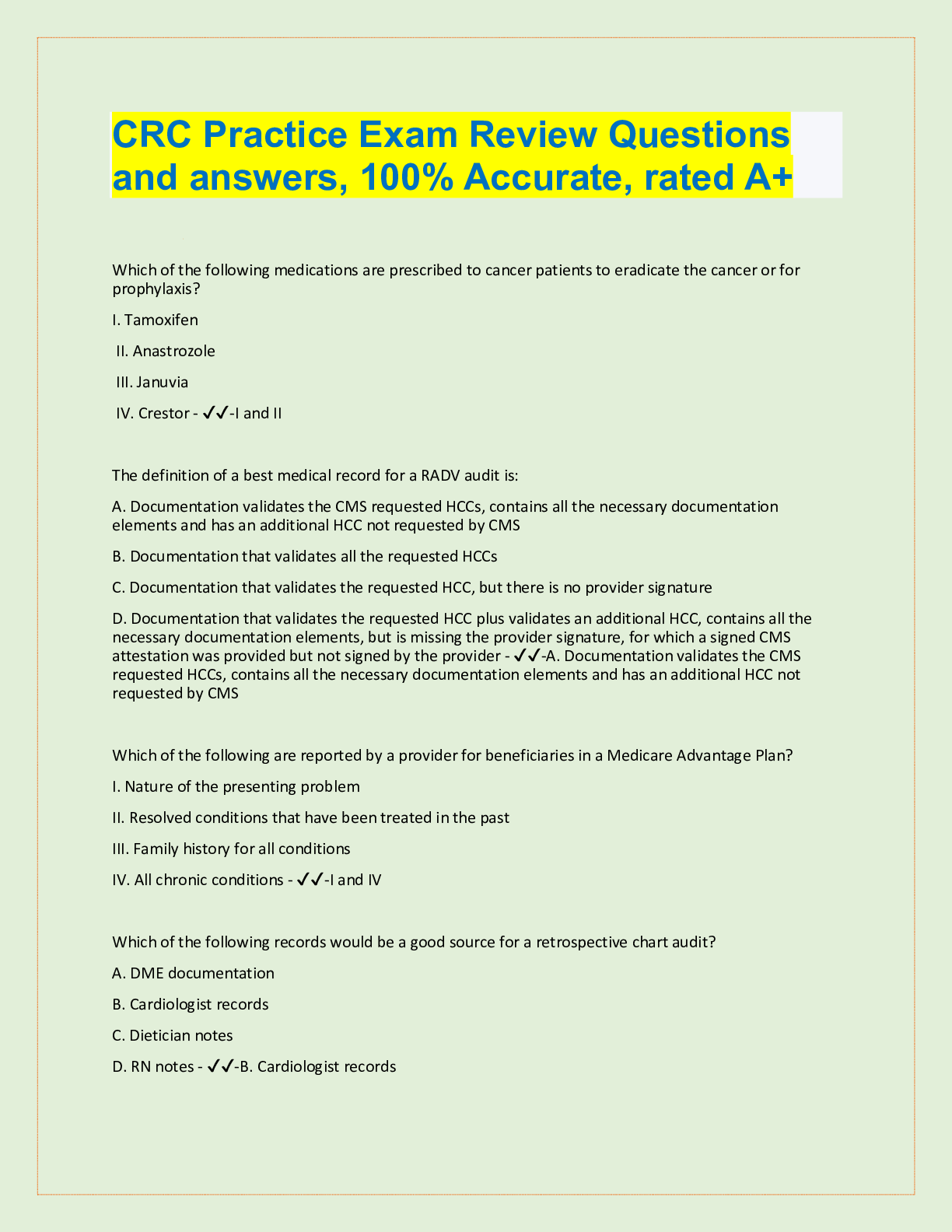

 Exam Preparation With Correct Answers Graded A+-1.png)
